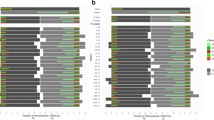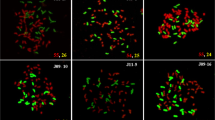Abstract
Festulolium hybrids are being increasingly used worldwide as forage grasses. This is due to their superior agronomic characteristics, which combine yield performance of ryegrasses (Lolium multiflorum and L. perenne) and tolerance against abiotic stress of fescues (Festuca pratensis, F. arundinacea and F. arundinacea var. glaucescens). Despite the widespread use, only fragmentary information exists on their genomic constitution. We used genomic in situ hybridization (GISH) to analyze genomic constitution of over 600 plants from almost all commercially available cultivars of Festulolium. Our results revealed a surprisingly large range of variation in the proportions of parental genomes and in the extent of intergenomic recombination. Using fluorescence in situ hybridization (FISH) with probes for ribosomal DNA, we assessed the frequency of recombination and elimination of particular chromosomes and chromosome groups in three contrasting Festulolium cultivars. This study provides novel information that will aid in understanding the relationship between a genetic make-up and the phenotype of Festulolium hybrids. Our results indicate that GISH might be a useful tool to aid in Festulolium breeding and provide data for a more detailed description of registered cultivars.



Similar content being viewed by others
References
Bennett MD, Finch RA, Barclay IR (1976) The time rate and mechanism of chromosome elimination in Hordeum hybrids. Chromosoma 54:175–200
Buckner RC, Burrus PB, Bush LP (1977) Registration of Kenhy tall fescue. Crop Sci 17:672–673
Buckner RC, Boling JA, Burrus PB II, Bush LP, Hemken RA (1983) Registration of Johnstone tall fescue. Crop Sci 23:399–400
Canter PH (2000) The use of genomic in situ hybridization (GISH) to locate introgressed chromosome segments from winter-hardy Festuca in a cold-sensitive Lolium background. Newsletters of Genet Soc, September 2000:29–30
Canter PH, Pašakinskienė I, Jones RN, Humphreys MW (1999) Chromosome substitutions and recombination in the amphiploid Lolium perenne × Festuca pratensis cv. Prior (2n = 4x = 28). Theor Appl Genet 98:809–814
Casler MD, Pitts PG, Rose-Fricker C, Bilkey PC, Wipff JK (2001) Registration of ‘Spring Green’ Festulolium. Crop Sci 41:1365–1366
Feldman M, Levy AA (2005) Allopolyploidy—a shaping force in the evolution of the wheat genomes. Cytogenet Genome Res 109:250–258
Fojtík A (1994) Methods of grass improvement used at the plant breeding station Hladké Životice. Genet Pol 35A:25–31
Fojtík A (1998) Šlechtění a využití Festulolium v České Republice. Proc. National Conference Festulolium—Achievements and Perspectives, Poznań, Poland, November 1998, pp 27–32 (in Czech)
Fukui K, Kamisugi Y, Sakai F (1994) Physical mapping of 5S rDNA loci by direct-cloned biotinylated probes in barley chromosomes. Genome 37:105–11
Gerlach WL, Bedbrook JR (1979) Cloning and characterization of ribosomal RNA genes from wheat and barley. Nucleic Acids Res 8:4851–4855
Ghesquière M, Zwierzykowski Z, Poisson C, Jadas-Hecart J (1993) Amphitetraploid festulolium (Lolium multiflorum × Festuca arundinacea var. glaucescens): chromosome stability and female fertility over intercrossing generations. In: Proceedings of XVIIth International Grassland Congress, Palmerston North, New Zealand, February 1993, pp 451–453
Ghesquière M, Emile J-C, Jadas-Hécart J, Mousset C, Traineau R, Poisson C (1996) First in vivo assessment of feeding value in Festulolium hybrids using Festuca arundinacea var. glaucescens and selection for palatability. Plant Breed 115:238–244
Humphreys MW, Pašakinskienė I (1996) Chromosome painting to locate genes for drought resistance transferred from Festuca arundinacea into Lolium multiflorum. Heredity 77:530–534
Humphreys MW, Thomas HM, Morgan WG, Meredith MR, Harper JA, Thomas H, Zwierzykowski Z, Ghesquière M (1995) Discriminating the ancestral progenitors of hexaploid Festuca arundinacea using genomic in situ hybridization. Heredity 75:171–174
Humphreys M, Thomas HM, Harper J, Morgan G, James A, Zare AG, Thomas H (1997) Dissecting drought- and cold-tolerance traits in the Lolium-Festuca complex by introgression mapping. New Phytol 137:55–60
Humphreys MW, Zare AG, Pašakinskienė I, Thomas H, Rogers WJ, Collin HA (1998) Interspecific genomic rearrangements in androgenic plants derived from a Lolium multiflorum × Festuca arundinacea (2n = 5x = 35) hybrid. Heredity 80:78–82
Inoue M, Cai H (2004) Sequence analysis and conversion of genomic RFLP markers to STS and SSR markers in Italian ryegrass (Lolium multiflorum Lam.). Breed Sci 54:245–251
Jauhar PP (1993) Cytogenetics of the Festuca-Lolium complex, relevance to breeding, monographs on theoretical and applied genetics, vol 18. Springer, Berlin Heidelberg New York, p. 255
Jensen LB, Muylle H, Arens P, Andersen CH, Holm PB, Ghesquière M, Julier B, Lübberstedt T, Nielsen KL, de Riek J, Roldán-Ruiz I, Roulund N, Taylor C, Vosman B, Barre P (2005) Development and mapping of a public reference set of SSR markers in Lolium perenne L. Mol Ecol Notes 5:951–955
King J, Armstead IP, Donnison IS, Thomas HM, Jones RN, Kearsey MJ, Roberts LA, Thomas A, Morgan WG, King IP (2002) Physical and genetic mapping in the grasses Lolium perenne and Festuca pratensis. Genetics 161:315–324
Kopecky D, Lukaszewski AJ, Gibeault V (2005a) Reduction of ploidy level by androgenesis in intergeneric Lolium-Festuca hybrids for turf grass breeding. Crop Sci 45:274–281
Kopecký D, Lukaszewski AJ, Doležel J (2005b) Genomic constitution of Festulolium cultivars released in the Czech Republic. Plant Breed 124:454–458
Kosmala A, Zwierzykowski Z, Gąsior D, Rapacz M, Zwierzykowska E, Humphreys MW (2006) GISH/FISH mapping of genes for freezing tolerance transferred from Festuca pratensis to Lolium multiflorum. Heredity 96:243–251
Lewis EJ (1975) Festuca L. × Lolium L. = Festulolium Aschers and Graebn. In: Stace CA (ed) Hybridization and the flora of the British Isles. Academic, London, pp 547–552
Lewis EJ, Tyler BF, Chorlton KH (1973) Development of Lolium-Festuca hybrids. Annual Report of the Welsh Plant Breeding Station for 1972, pp 34–37
Lukaszewski AJ, Lapiński B, Rybka K (2005) Limitations of in situ hybridization with total genomic DNA in routine screening for alien introgressions in wheat. Cytogen Genome Res 109:373–377
Masoudi-Nejad A, Nasuda S, McIntosh RA, Endo TR (2002) Transfer of rye chromosome segments to wheat by gametocidal system. Chromosome Res 10:349–357
Morgan WG, King IP, Koch S, Harper JA, Thomas HM (2001) Introgression of chromosomes of Festuca glaucescens into Lolium multiflorum revealed by genomic in situ hybridization (GISH). Theor Appl Genet 103:696–701
Osborne RT, Thomas H, Lewis EJ (1977) Lolium-Festuca amphiploids. Annual report of the Welsh plant breeding station for 1976, pp 105–106
Pašakinskienė I, Griffiths CM, Bettany AJE, Paplauskiene V, Humphreys MW (2000) Anchored simple-sequence repeats as primers to generate species-specific DNA markers in Lolium and Festuca grasses. Theor Appl Genet 100:384–390
Schwarzacher T, Leitch AR, Bennett MD, Heslop-Harrison JS (1989) In situ localization of parental genomes in a wide hybrid. Ann Bot 64:315–324
Thomas H, Humphreys MO (1991) Progress and potential of interspecific hybrids of Lolium and Festuca. J Agric Sci 117:1–8
Thomas HM, Morgan WG, Meredith MR, Humphreys MW, Thomas H, Leggett JM (1994) Identification of parental and recombined chromosomes in hybrid derivatives of Lolium multiflorum × Festuca pratensis by genomic in situ hybridization. Theor Appl Genet 88:909–913
Thomas HM, Harper JA, Meredith MR, Morgan WG, Thomas ID, Timms E, King IP (1996) Comparison of ribosomal DNA sites in Lolium species by fluorescence in situ hybridization. Chromosome Res 4:486–490
Thomas HM, Harper JA, Meredith MR, Morgan WG, King IP (1997) Physical mapping of ribosomal DNA sites in Festuca arundinacea and related species by in situ hybridization. Genome 40:406–410
Zwierzykowski Z (2004) Amphiploid and introgression breeding within the Lolium-Festuca complex—achievements and perspectives. In: Yamada T, Takamizo T (eds) Development of a novel grass with environmental stress tolerance and high forage quality through intergeneric hybridization between Lolium and Festuca. NARO, Tsukuba, Japan, pp 17–29
Zwierzykowski Z, Lukaszewski AJ, Leśniewska A, Naganowska B (1998a) Genomic structure of androgenic progeny of pentaploid hybrids, Festuca arundinacea × Lolium multiflorum. Plant Breed 117:457–462
Zwierzykowski Z, Tayyar R, Brunell M, Lukaszewski AJ (1998b) Genome recombination in intergeneric hybrids between tetraploid Festuca pratensis and Lolium multiflorum. J Hered 89:324–328
Zwierzykowski Z, Zwierzykowska E, Kosmala A, Łuczak M, Jokś W (2003) Genome recombination in early generations of Festuca pratensis × Lolium perenne hybrids. In: Zwierzykowski Z, Surma M, Kachlicki P (eds) Application of novel cytogenetic and molecular techniques in genetics and breeding of the grasses. Institute of Plant Genetics PAS, Poznań, Poland, pp 63–70
Acknowledgments
We are grateful to Dr. Vladimír Černoch for providing plants of Festulolium hybrids and to Dr. Marie Kubaláková for providing the probe for 5S rDNA. This work was supported by the Academy of Sciences of the Czech Republic (grant award no. S5038104).
Author information
Authors and Affiliations
Corresponding author
Additional information
Communicated by B. Friebe
Rights and permissions
About this article
Cite this article
Kopecký, D., Loureiro, J., Zwierzykowski, Z. et al. Genome constitution and evolution in Lolium × Festuca hybrid cultivars (Festulolium). Theor Appl Genet 113, 731–742 (2006). https://doi.org/10.1007/s00122-006-0341-z
Received:
Accepted:
Published:
Issue Date:
DOI: https://doi.org/10.1007/s00122-006-0341-z




